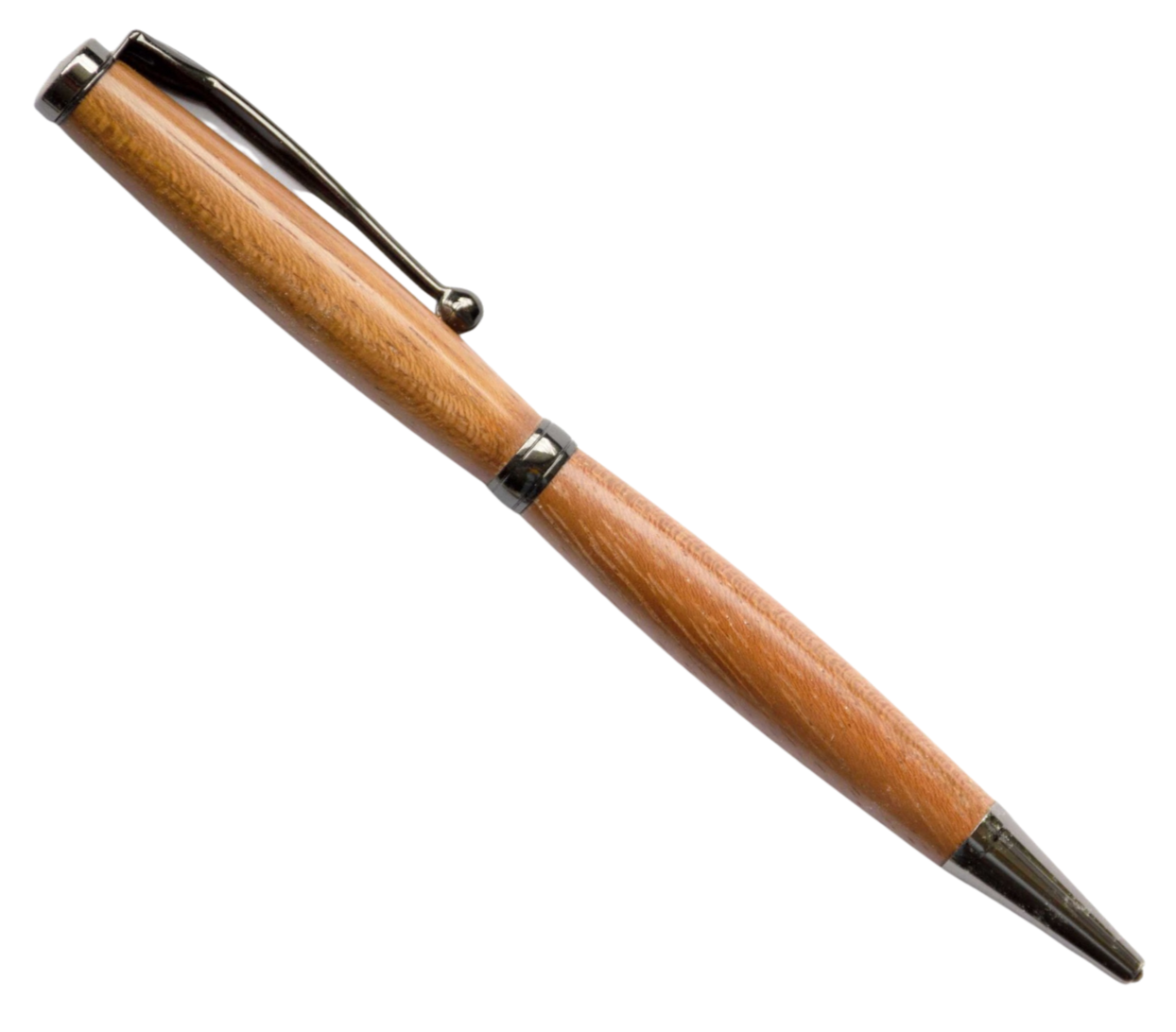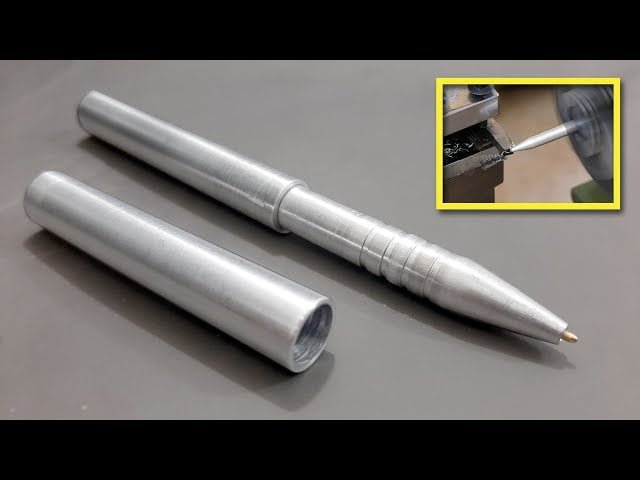Table of Contents
Metal pen turning involves shaping metal blanks into pens using a lathe. It requires precision and skill to create custom designs.
Metal pen turning is a popular craft that combines artistry and technical skill. Enthusiasts use a lathe to shape metal blanks into intricate, custom-designed pens. This hobby allows for the creation of unique, high-quality writing instruments that stand out from mass-produced options.
The process involves selecting the right metal, preparing the blank, and using various lathe tools to achieve the desired shape and finish. Many turners find joy in the hands-on experience and the satisfaction of producing a functional piece of art. Metal pen turning not only hones craftsmanship but also offers a rewarding creative outlet.

Credit: wlccnc.en.made-in-china.com
The Art Of Metal Pen Turning
Creating metal pens requires several essential tools and materials. A lathe is crucial for shaping the pen. High-quality metal blanks are necessary for the pen body. Cutting tools and sandpaper help in refining the shape. Polishing compounds give the pen a shiny finish. Safety gear, like gloves and goggles, protect you during the process. Owning a drill press aids in making precise holes. A deburring tool is useful for cleaning edges.
Pen turning began centuries ago with simple wooden pens. Over time, metal pens emerged due to their durability. Early artisans used basic hand tools. Modern pen turning uses advanced machinery. Innovation has led to a variety of designs and materials. Today, pen turning is a popular hobby and craft. Many enthusiasts enjoy creating unique, custom pens. The craft continues to evolve with new techniques and tools.

Credit: acemetalpen.com
Choosing The Right Metal For Your Pen
Brass is a popular choice. It has a golden color and resists tarnish. Aluminum is lightweight and easy to machine. Stainless steel is very strong and resistant to rust. Copper has a unique reddish color and antimicrobial properties. Titanium is super strong and corrosion-resistant.
Different metals provide unique benefits. Brass makes pens look elegant. Aluminum makes them easy to carry. Stainless steel ensures they last long. Copper adds a special touch and fights germs. Titanium ensures your pen is durable and long-lasting. Choosing the right metal can make your pen special and useful.
Design Principles For Metal Pens
Creating a metal pen requires a blend of beauty and comfort. A pen should look elegant and feel good in your hand. Designers focus on smooth lines and balanced weight. The pen should not be too heavy or too light. Crafting a pen involves using high-quality materials. These materials add durability and a touch of luxury. The grip area needs special attention. It should allow for long writing sessions without causing discomfort. Small details like the clip design and color can make a big difference. Every element should contribute to both aesthetic appeal and ease of use.
Personal style can shine through in a custom metal pen. Choose unique finishes and engraving options. Some prefer a sleek, modern look. Others might like a more classic design. Adding initials or a name makes the pen truly unique. Select colors and patterns that reflect your personality. Metal pens can be tailored to suit any taste. Each pen becomes a personal statement. This blend of customization and quality makes metal pens special.
Preparing Your Workspace
Make sure your lathe is on a stable surface. Check that all parts are secure. Clean the area around your lathe. Keep tools within reach. Ensure good lighting in your workspace. Position the lathe at a comfortable height. This helps to avoid strain.
Use a sturdy table or bench. Attach the lathe firmly to the surface. This prevents movement during use. Organize your tools nearby. Place a mat under your lathe. This catches metal shavings. Have a trash bin close by. Clean up regularly to maintain safety.
Always wear safety goggles. Protect your eyes from flying debris. Use ear protection. Lathes can be loud. Wear a dust mask. Metal dust can harm your lungs. Tie back long hair. Loose hair can get caught in the machine.
Do not wear loose clothing. It can catch on moving parts. Keep your workspace clean. Remove any clutter. Follow the lathe’s instructions. Never force the tool. Let the machine do the work. Stop the lathe before making adjustments.
Step-by-step Process Of Pen Turning
Select a high-quality metal blank. Clean the blank thoroughly with alcohol. This removes any oil or dirt. Measure the blank and mark the center. Use a punch tool to create a small dent. This helps the drill bit stay centered. Secure the blank in a vice. Drill a hole through the center using a metal drill bit. Ensure the hole is straight and clean.
Mount the metal blank on the lathe. Turn on the lathe at a low speed. Use a roughing gouge to shape the blank. Remove small amounts of metal at a time. Smooth the surface with a skew chisel. Sand the pen blank with fine-grit sandpaper. Gradually increase the lathe speed for a smoother finish. Apply a polishing compound for a shiny look.
Finishing Techniques For A Professional Look
Polishing a metal pen makes it shine. Use fine-grit sandpaper to smooth the surface. After sanding, apply a polishing compound. Buff the pen with a soft cloth. This removes scratches and gives a bright finish.
Rotary tools can speed up the polishing process. Be careful to avoid over-polishing. Over-polishing can damage the metal. Always wear safety glasses and gloves. This keeps you safe while working.
Coatings protect the pen from damage. Apply a clear coat to seal the metal. Clear coats can be spray or brush-on. Make sure the surface is clean before applying. This ensures the coating sticks well.
Some prefer lacquer for a glossy finish. Others use wax for a natural look. Both options offer protection. Allow the coating to dry completely. This ensures a durable finish. Repeat layers if needed for extra protection.
Troubleshooting Common Pen Turning Issues
Small particles can cause blemishes on your pen. Clean your tools and workspace often. Sharp tools help in getting smooth cuts. Sand your pen blanks properly to avoid flaws. Use fine-grit sandpaper for a smooth finish.
Uneven surfaces can ruin your pen. Make sure your lathe is stable and level. Turn your pen blanks at a consistent speed. Apply even pressure when working on the pen. Check your pen regularly for any uneven spots. Sand and polish to achieve a smooth surface.
Advanced Pen Turning Skills
Inlaying and engraving add unique designs to metal pens. Use fine tools for precise work. Choose materials like wood, resin, or stone for inlays. Engrave patterns or text with care. Practice on scrap metal first. This helps in perfecting the technique. Clean the surface before starting. This ensures a smooth finish. Seal the inlay with a clear coat. It protects the design and adds shine.
Custom clips and accents enhance the look of your metal pen. Design your clip to match the pen’s style. Use sturdy materials like brass or stainless steel. Shape the clip with small tools. Attach it securely to the pen. Add accents like rings or bands. These can be decorative or functional. Polish the metal to a high shine. This gives a professional finish.
Marketing Your Handcrafted Metal Pens
Creating a unique brand is important. Start with a catchy name. Design a logo that stands out. Use social media to show your pens. Share stories about your process. This helps people feel connected. Offer personalized options. People love custom items. Make your brand consistent. Use the same colors and fonts everywhere. This helps people remember you.
Sell your pens on online platforms. Sites like Etsy and eBay are good. Take clear photos of your pens. Write detailed descriptions. This helps buyers know what they are getting. Craft shows are also great. Set up a nice booth. Display your pens neatly. Talk to customers. Explain what makes your pens special. Offer business cards. This helps people find you later. Both online and offline sales can help your business grow.
Joining The Community Of Metal Pen Turners
Joining forums can help you learn new techniques. Many pen turners share tips and tricks. Social media groups offer a space to share your work. You can ask questions and get feedback. These groups often have experts who can help you. You can find groups on Facebook and Reddit.
Workshops are great for hands-on learning. You can meet other pen turners in person. Many workshops offer tools and materials for practice. Meetups allow you to network with other pen turners. You can share ideas and techniques. Local clubs often host these events.

Credit: www.thewoodreserve.com
Frequently Asked Questions
What Are The Different Types Of Pens For Turning?
Different types of pens for turning include ballpoint, rollerball, fountain, and gel pens. Each offers unique writing experiences.
What Rpm For Pen Turning?
Optimal RPM for pen turning is 3,000 to 4,000. Lower speeds prevent wood burning and improve control. Adjust speed for material.
What Does It Mean To Turn Pens?
Turning pens means crafting pens using a lathe. It involves shaping wood or acrylic blanks into pen bodies. This hobby combines woodworking skills with creativity.
Are Metal Pens Safe?
Yes, metal pens are generally safe. They are durable and often hypoallergenic. Ensure they are from reputable brands.
Conclusion
Creating your own metal pen offers a rewarding experience. It combines craftsmanship with functionality. Whether for personal use or as a gift, a custom metal pen stands out. Start your pen turning journey today and enjoy the satisfaction of crafting something unique and durable.
Happy turning!
